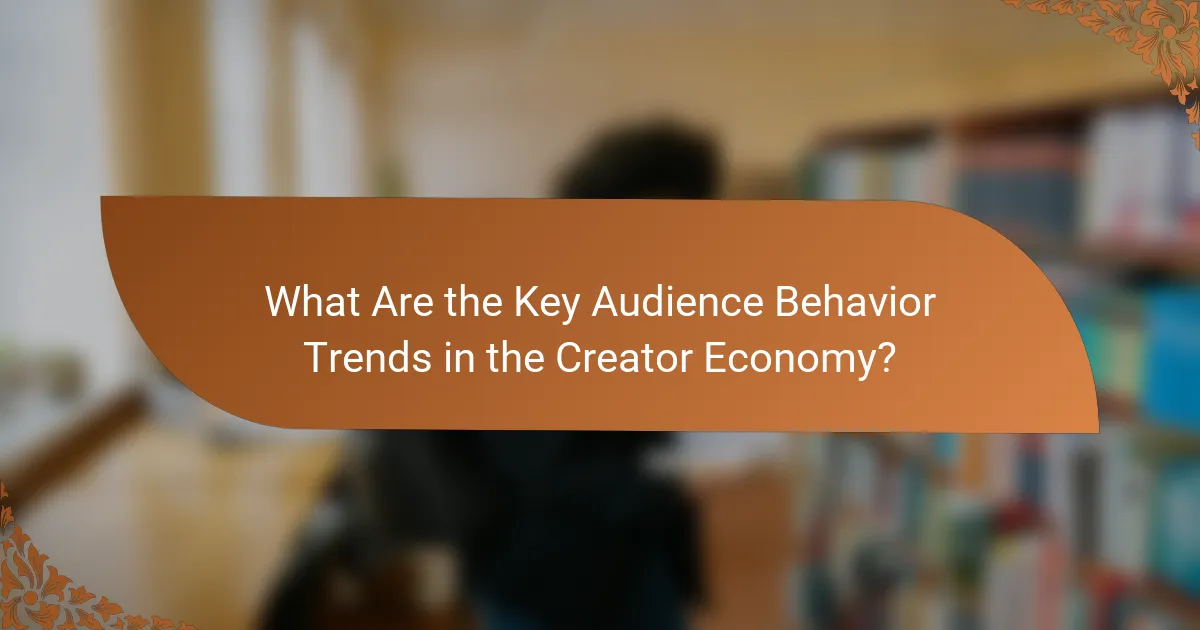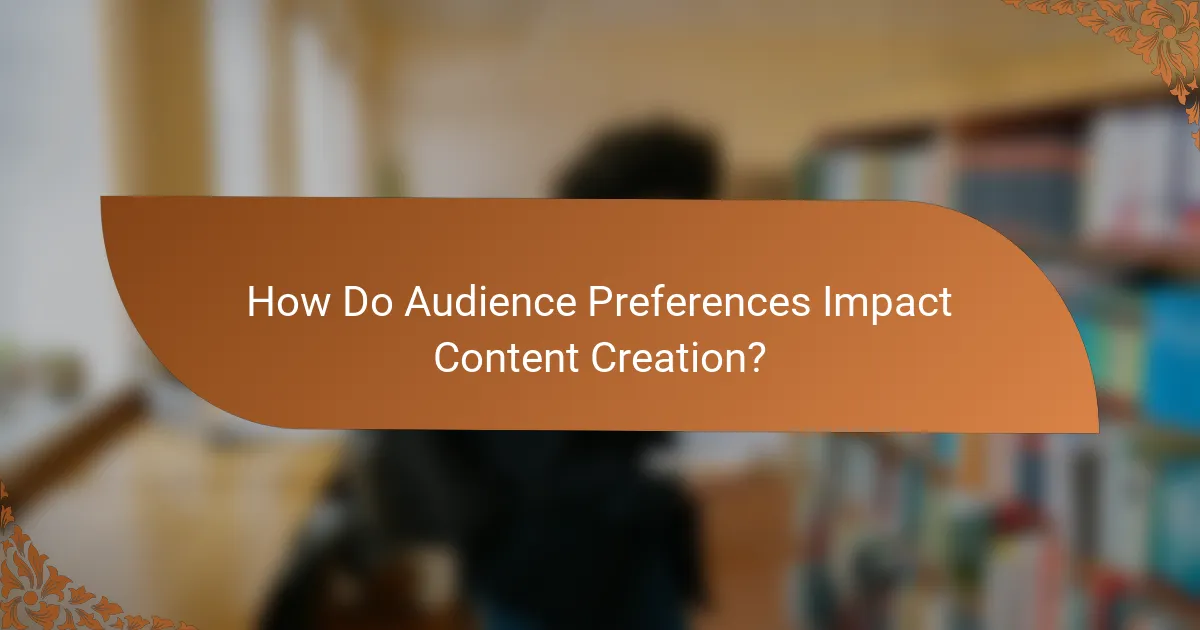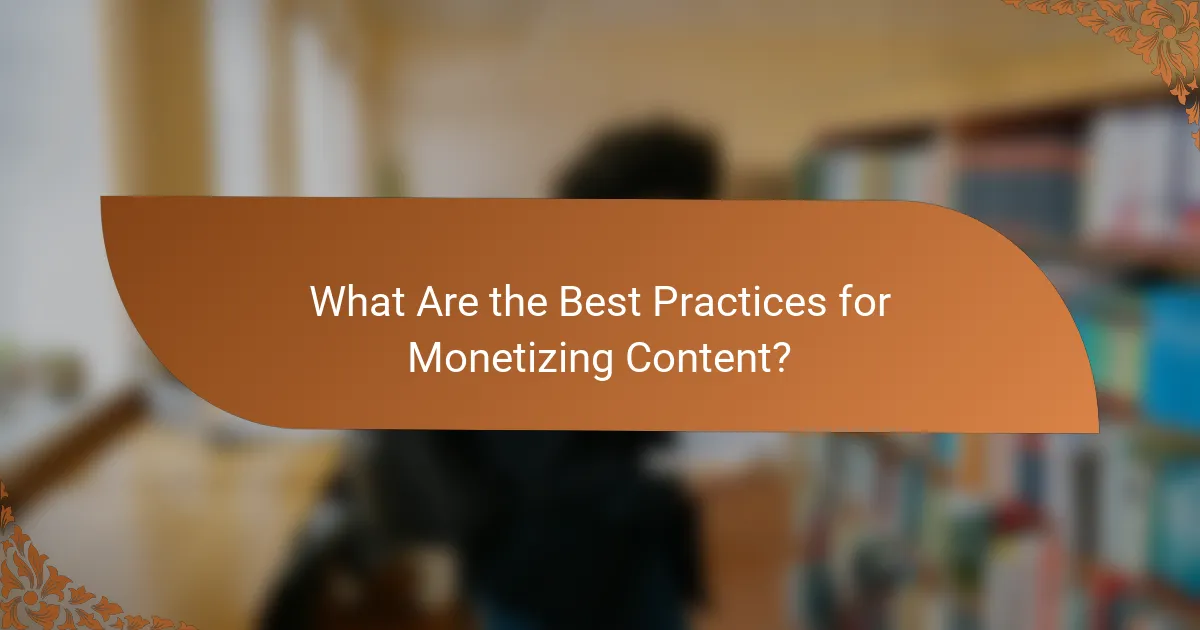The creator economy is evolving rapidly, driven by significant audience behavior trends that influence content consumption and monetization. Key trends include a rise in live streaming, a preference for short-form content, and a growing demand for authentic brand partnerships, all of which shape how creators engage with their audiences. By understanding these preferences, creators can tailor their content to foster deeper connections and enhance audience loyalty.

What Are the Key Audience Behavior Trends in the Creator Economy?
The creator economy is witnessing several key audience behavior trends that shape how content is consumed and monetized. These trends include increased engagement through live streaming, a shift towards short-form content, the rise of niche communities, a preference for authentic brand partnerships, and growth in subscription-based models.
Increased engagement through live streaming
Live streaming has become a powerful tool for creators to engage their audiences in real-time. This format allows for direct interaction through comments and questions, fostering a sense of community and immediacy. Creators can host Q&A sessions, tutorials, or live events, which often lead to higher viewer retention compared to pre-recorded content.
Platforms like Twitch and YouTube Live have seen significant growth, with many creators leveraging these tools to boost their visibility and foster loyalty among their followers. Engaging with audiences during live streams can enhance the overall experience and encourage more frequent participation.
Shift towards short-form content consumption
Short-form content, such as TikTok videos and Instagram Reels, has gained immense popularity, reflecting a shift in audience preferences. Viewers are increasingly drawn to quick, digestible content that can be consumed in a matter of seconds. This trend emphasizes the need for creators to capture attention rapidly and deliver impactful messages succinctly.
Creators should consider focusing on storytelling techniques that fit within these brief formats, using eye-catching visuals and hooks to retain viewer interest. As attention spans shorten, adapting content strategies to prioritize brevity can lead to greater engagement and reach.
Rise of niche communities
Niche communities are flourishing within the creator economy, as audiences seek content that resonates with their specific interests. This trend allows creators to build dedicated followings by focusing on specialized topics, whether it’s a particular hobby, lifestyle, or profession. Engaging with these communities fosters loyalty and encourages deeper connections.
Creators should identify and cater to these niche audiences by producing tailored content that addresses their unique needs and preferences. This approach not only enhances engagement but also opens up opportunities for targeted brand partnerships and collaborations.
Preference for authentic brand partnerships
Audiences are increasingly valuing authenticity in brand partnerships, favoring creators who promote products and services that align with their personal values. This trend highlights the importance of transparency and genuine endorsements, as viewers are more likely to trust creators who share their honest opinions.
Creators should prioritize collaborations that feel natural and relevant to their content. By being selective about brand partnerships, they can maintain credibility and strengthen their relationship with their audience, ultimately leading to more effective marketing outcomes.
Growth in subscription-based models
Subscription-based models are on the rise, allowing creators to monetize their content directly through platforms like Patreon or YouTube Memberships. This model provides a steady income stream and fosters a closer relationship with subscribers, who often receive exclusive content and perks in return for their support.
Creators should consider offering tiered subscription options to cater to different audience segments, providing varying levels of access and benefits. This approach can enhance subscriber retention and encourage more fans to support their favorite creators financially.

How Do Audience Preferences Impact Content Creation?
Audience preferences significantly shape content creation by guiding creators on what resonates with viewers. Understanding these preferences helps in tailoring content that engages and retains an audience effectively.
Demand for personalized content
Audiences increasingly expect personalized content that reflects their interests and preferences. This demand drives creators to utilize data analytics and audience insights to curate tailored experiences, enhancing viewer satisfaction.
For instance, platforms like YouTube and Spotify leverage algorithms to recommend content based on user behavior, creating a more engaging experience. Creators should focus on niche topics or themes that resonate with specific audience segments to meet this demand.
Influence of social media algorithms
Social media algorithms play a crucial role in determining which content gets visibility. These algorithms prioritize engagement metrics such as likes, shares, and comments, influencing how creators strategize their content to maximize reach.
To adapt, creators should encourage interaction through calls to action, such as asking questions or prompting discussions. Regularly analyzing engagement data can help refine content strategies to align with algorithm changes and audience preferences.
Importance of storytelling techniques
Effective storytelling techniques are essential for capturing and maintaining audience attention. Creators who master the art of storytelling can evoke emotions, making their content more relatable and memorable.
Utilizing elements like conflict, resolution, and character development can enhance narratives. Creators should aim to weave personal experiences or relatable anecdotes into their content, fostering a deeper connection with their audience.

What Are Effective Strategies for Engaging Audiences?
Effective strategies for engaging audiences in the creator economy involve understanding their preferences and behaviors. By leveraging data, user-generated content, and interactive formats, creators can foster deeper connections and enhance audience loyalty.
Utilizing data analytics for insights
Data analytics offers valuable insights into audience behavior, preferences, and engagement patterns. By analyzing metrics such as view counts, watch time, and interaction rates, creators can tailor their content to meet audience needs more effectively.
Consider using tools like Google Analytics or social media insights to track performance. Regularly reviewing this data helps identify trends and informs content strategy, allowing for adjustments that resonate with the audience.
Leveraging user-generated content
User-generated content (UGC) is a powerful way to engage audiences, as it fosters a sense of community and authenticity. Encouraging followers to share their experiences or creations related to your brand can enhance engagement and build trust.
For example, running contests or challenges that invite users to submit their content can generate excitement and increase visibility. Highlighting UGC on your platforms not only showcases your audience but also encourages others to participate.
Implementing interactive content formats
Interactive content formats, such as polls, quizzes, and live Q&A sessions, can significantly boost audience engagement. These formats invite participation and create a two-way dialogue, making audiences feel valued and involved.
Consider incorporating interactive elements into your content strategy. For instance, using Instagram Stories to conduct polls or hosting live streams on platforms like YouTube can enhance real-time interaction and keep audiences engaged longer.

How Do Demographics Influence Creator Success?
Demographics significantly impact creator success by shaping audience preferences and engagement levels. Understanding the age, location, and gender of your audience can help tailor content strategies that resonate more effectively with viewers.
Age-related content preferences
Different age groups exhibit distinct content preferences that creators should consider. For instance, younger audiences, such as Gen Z, often favor short-form videos and interactive content, while older demographics may prefer longer, in-depth articles or tutorials.
Creators can enhance engagement by analyzing age-related trends, such as the popularity of platforms like TikTok among younger users versus Facebook’s stronger presence with older generations. Tailoring content to these preferences can lead to higher viewer retention and interaction rates.
Impact of geographic location on trends
Geographic location plays a crucial role in shaping content trends and audience behavior. For example, creators in urban areas might find success with lifestyle content that reflects city living, while those in rural regions may focus on outdoor activities or local culture.
Additionally, cultural differences can influence content consumption. Creators should research regional preferences and adapt their messaging and style accordingly, ensuring relevance and relatability to their target audience.
Gender differences in consumption habits
Gender can influence consumption habits, with men and women often gravitating towards different types of content. For instance, women may be more engaged with beauty and wellness content, while men might prefer technology and gaming topics.
Creators should consider these differences when developing content strategies. Engaging both genders can involve creating diverse content that appeals to a broader audience, ensuring that messaging resonates across various demographics.

What Are the Best Practices for Monetizing Content?
To effectively monetize content, creators should adopt a multi-faceted approach that combines various revenue streams, engages audiences through affiliate marketing, and fosters a loyal subscriber base. This strategy not only diversifies income but also builds a sustainable business model.
Diverse revenue streams for creators
Creators can enhance their income by exploring multiple revenue streams such as ad revenue, merchandise sales, sponsored content, and subscription services. Each stream offers unique advantages; for example, ad revenue can provide passive income, while merchandise sales allow for brand expansion.
Consider experimenting with platforms like Patreon for subscriptions or Teespring for merchandise. A balanced mix of these options can help mitigate risks associated with relying on a single income source.
Effective use of affiliate marketing
Affiliate marketing can be a powerful tool for creators to earn commissions by promoting products or services. By integrating affiliate links into content, creators can generate income without needing to develop their own products.
To maximize effectiveness, choose affiliate programs that align with your audience’s interests. For instance, a tech reviewer might partner with electronics retailers. Transparency about affiliate relationships is crucial; always disclose partnerships to maintain trust with your audience.
Building a loyal subscriber base
A loyal subscriber base is essential for sustainable monetization. Engaging content, regular interaction, and exclusive offerings can help retain subscribers. Consider providing value through behind-the-scenes content or early access to new releases.
Utilizing email newsletters or social media platforms can enhance communication with subscribers. Focus on creating a community where subscribers feel valued, as this can lead to increased retention and higher lifetime value.



